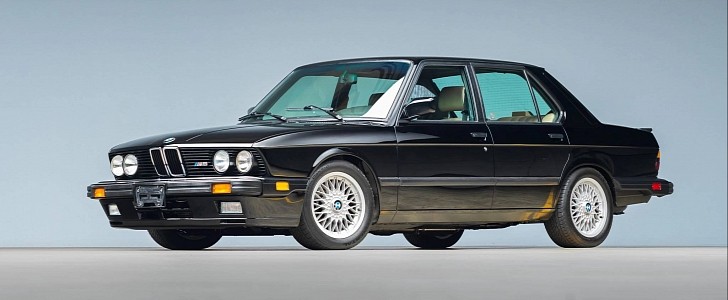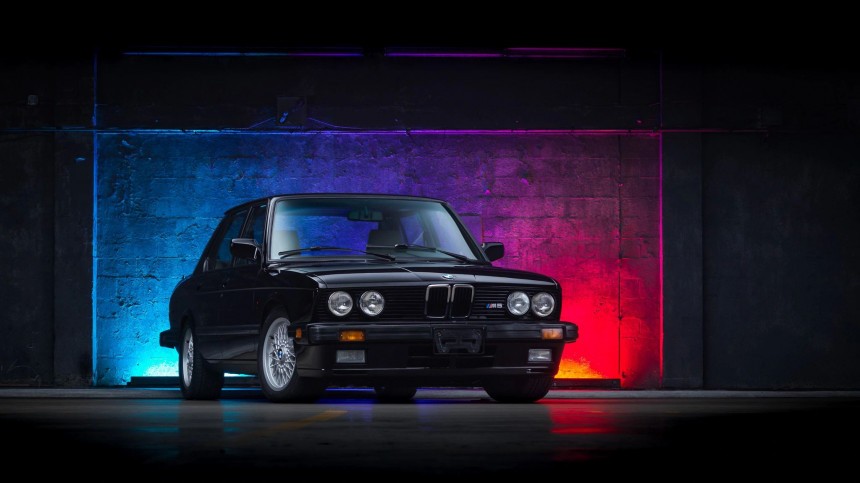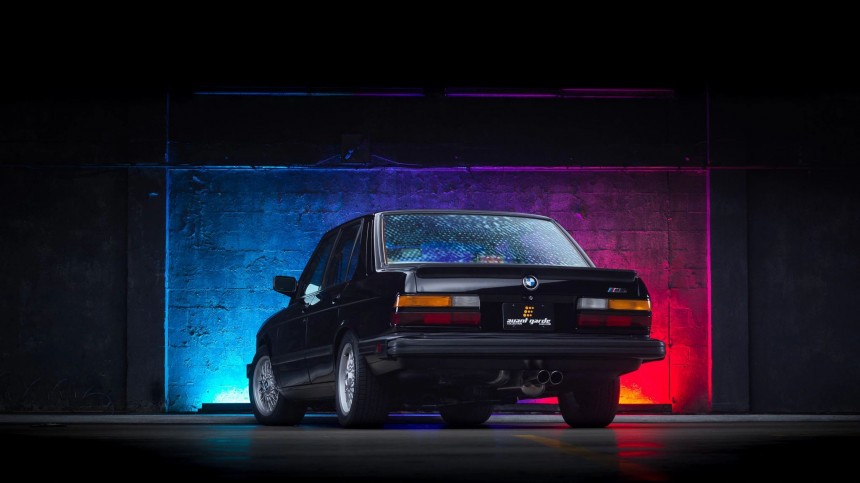When BMW introduced the M5 at the 1985 Amsterdam Motor Show, certain people didn’t really notice this fellow because performance sedans weren’t exactly new. The Maserati Quattroporte comes to mind, along with the Mercedes-Benz 450 SEL 6.9 from the W116 generation, the Jaguar Mk II, and the gorgeous Alfa Romeo Giulietta. But the Bavarians ultimately managed to define the segment, cementing the Motorsport division’s reputation for great-handling sedans with proper oomph.
Inspired by the E12 M535i that we’ve covered in a previous article, the E28 M5 was initially manufactured at the Preussenstrasse facility. Later on, it was moved to Daimlerstrasse in Garching. Production came to a halt in 1988, totaling 2,241 examples of the breed. These cars are split between five regional variants, of which the North American model is the most numerous, with 1,340 copies under its belt. The E28 M5 for the Japanese market, by comparison, numbers 30 units as per the production records.
Just like the M635CSi, the four-door sedan had its battery relocated to the trunk for better weight distribution. Sitting on the same 2,625-millimeter wheelbase as lesser versions of the E28, the M5 flaunts MacPherson struts up front and semi-trailing arms in the rear. Bilstein shocks front and rear are joined by anti-roll bars that measure 21 and 14 millimeters.
Gifted with forged alloys wrapped in Michelin-supplied rubber shoes, the M5 stops on a dime thanks to 300- and 284-mm brake rotors. A 70-liter fuel tank feeds the M88/3 engine up front, a six-cylinder lump derived from the 3.5-liter mill that equips the midship M1. Based on the race-spec M49, the M88 is the first BMW road-going engine to feature dual overhead cams.
There are, however, some notable differences compared to the M1’s engine, chief among which is the wet-sump lubrication system. The 24-valve motor also rocks Bosch Motronic engine management, different conrods and pistons, and a 10.5:1 compression ratio compared to 9.0:1.
Equipped with a crossflow cylinder head and six individual throttle bodies, the M88/3 brings the point home with the M Power script. The cast-iron block is complemented by aluminum alloy for the head. From 3,453 cubic centimeters attributed to a 93.4-mm (3.7") bore and 84-mm (3.3") stroke, the straight-six engine peaks at 282 ponies (286 ps) and 251 pound-feet (340 Nm) of torque.
For the Canadian and U.S. markets, the Munich-based automaker used a detuned M88/3 internally known as the S38B35. The biggest difference between these siblings comes in the guise of the catalytic converters.
Also featured in Japanese cars, the S38 flaunts the BMW M Power script, a simplified exhaust manifold instead of equal-length headers, and a 9.8:1 compression ratio. What’s more, we also have to mention the double-row timing chain versus the single-row timing chain of the M88. In this configuration, it makes 256 hp (260 ps) and 243 pound-feet (330 Nm).
Coupled with a five-speed manual transmission supplied by Getrag, the M5's motor puts those ponies down to the ground with the help of a limited-slip differential. Extremely similar to every other E28, the M5 boasts a matte-black plastic air dam that incorporates cooling intakes for the radiator and front brakes. The interior, meanwhile, differs from other 5ers by means of the Motorsport division’s colors on the steering wheel, gear knob, and front sport seats. The 8,000-rpm rev counter also incorporates the M logo.
Tipping the scales at 1,430 kilograms (3,153 pounds), the first-ever M5 can accelerate to 100 kilometers per hour (62 miles per hour) in 6.3 seconds. Top speed? Make that 245 kilometers per hour (152 miles per hour). BMW introduced the M-Technic body kit to the options list in September 1985.
Extras further include a driver airbag, metallic paint, leather upholstery, air conditioning, cruise control, and a rear sunblind. Come February 1986, BMW improved their pride and joy with M5-specific springs for the rear wheels.
The Bavarians upgraded their go-faster sedan in October 1986 with even thicker anti-roll bars: 25 millimeters (1") up front and 18 mm (0.7") for the rear end. As you'd expect from the rarest M5 of them all, finding a good one is hard.
But on the upside, prices aren’t as high as other collectibles from this era. The pictured car, for example, is a 1988 model that sold on Bring a Trailer for $46,500 in January 2022. At the other end of the spectrum, the auctions website sold an original-owner 1988 model for a cool $77,500.
Just like the M635CSi, the four-door sedan had its battery relocated to the trunk for better weight distribution. Sitting on the same 2,625-millimeter wheelbase as lesser versions of the E28, the M5 flaunts MacPherson struts up front and semi-trailing arms in the rear. Bilstein shocks front and rear are joined by anti-roll bars that measure 21 and 14 millimeters.
Gifted with forged alloys wrapped in Michelin-supplied rubber shoes, the M5 stops on a dime thanks to 300- and 284-mm brake rotors. A 70-liter fuel tank feeds the M88/3 engine up front, a six-cylinder lump derived from the 3.5-liter mill that equips the midship M1. Based on the race-spec M49, the M88 is the first BMW road-going engine to feature dual overhead cams.
There are, however, some notable differences compared to the M1’s engine, chief among which is the wet-sump lubrication system. The 24-valve motor also rocks Bosch Motronic engine management, different conrods and pistons, and a 10.5:1 compression ratio compared to 9.0:1.
For the Canadian and U.S. markets, the Munich-based automaker used a detuned M88/3 internally known as the S38B35. The biggest difference between these siblings comes in the guise of the catalytic converters.
Also featured in Japanese cars, the S38 flaunts the BMW M Power script, a simplified exhaust manifold instead of equal-length headers, and a 9.8:1 compression ratio. What’s more, we also have to mention the double-row timing chain versus the single-row timing chain of the M88. In this configuration, it makes 256 hp (260 ps) and 243 pound-feet (330 Nm).
Coupled with a five-speed manual transmission supplied by Getrag, the M5's motor puts those ponies down to the ground with the help of a limited-slip differential. Extremely similar to every other E28, the M5 boasts a matte-black plastic air dam that incorporates cooling intakes for the radiator and front brakes. The interior, meanwhile, differs from other 5ers by means of the Motorsport division’s colors on the steering wheel, gear knob, and front sport seats. The 8,000-rpm rev counter also incorporates the M logo.
Extras further include a driver airbag, metallic paint, leather upholstery, air conditioning, cruise control, and a rear sunblind. Come February 1986, BMW improved their pride and joy with M5-specific springs for the rear wheels.
The Bavarians upgraded their go-faster sedan in October 1986 with even thicker anti-roll bars: 25 millimeters (1") up front and 18 mm (0.7") for the rear end. As you'd expect from the rarest M5 of them all, finding a good one is hard.
But on the upside, prices aren’t as high as other collectibles from this era. The pictured car, for example, is a 1988 model that sold on Bring a Trailer for $46,500 in January 2022. At the other end of the spectrum, the auctions website sold an original-owner 1988 model for a cool $77,500.

































